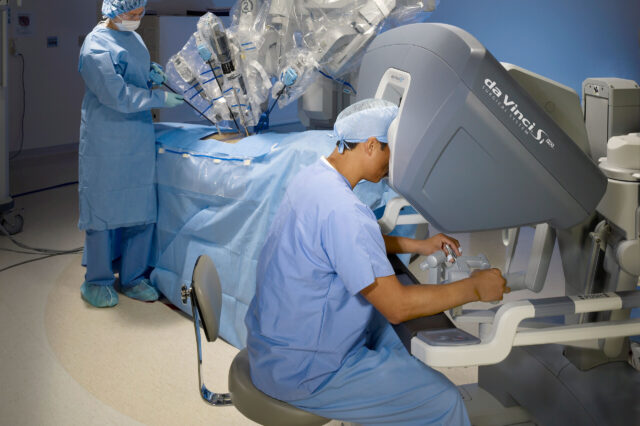Advances in surgical procedures involving the chest (thorax) mean that many surgeries no longer require opening the chest, but can be done with small incisions, typically less than the size of a dime, which provide great benefits for patients.
Surgeons at the UF Health Cardiovascular Center in Jacksonville are leaders in minimally invasive procedures, often pioneering techniques that have become standards of care in other hospitals.
Minimally invasive surgery, often called video-assisted thoracoscopic surgery, has been performed at UF Health Jacksonville since 1990, and our surgeons introduced robotic-assisted thoracic surgery to the region. Today, UF Health Jacksonville employs the da Vinci Xi Surgical System, the most advanced and precise robotic surgical platform available. We are the only hospital in the region to have two da Vinci Xi systems.
Physicians at UF Health Jacksonville offer more options for minimally invasive and robotically assisted surgeries than anywhere else in Northeast Florida and Southeast Georgia. In fact, some minimally invasive and robotic surgery techniques performed at UF Health Jacksonville are not offered anywhere else in the region.
We are the only facility providing robotic-assisted lung lobectomies for cancer patients.
Who qualifies?
You may be a candidate for minimally invasive and robotic thoracic surgery if you need any of the following:
- Biopsy of the lung or lymph nodes
- Removal of suspicious lung nodules
- Treatment of pneumothorax (air inside the chest from ruptured lung tissue)
- Diaphragmatic plication (tightening of a paralyzed diaphragm muscle to improve breathing)
- Removal of a section of a lung
- Removal of the entire lung
- Aortic valve repair or replacement
- Mitral valve repair or replacement
- Minimally invasive tricuspid valve repair or replacement
- Abnormal enlargement or aneurysms of the large arteries in the chest
- Artery revascularization
- Transmyocardial laser revascularization (TMR)
Surgeons at the UF Health Cardiovascular Center in Jacksonville are experts in these and a number of other cardiothoracic procedures.
Benefits of minimally invasive and robotic thoracic surgery
The small incisions used provide many advantages over traditional surgery, including:
- Quicker recovery
- Shorter hospital stay
- Less pain and scarring
- Less risk of infection
- Less blood loss and fewer transfusions
- Quicker return to normal activities
- Decreased need for post-surgery medications
- Smaller, less obvious incision
What to expect
Generally, your surgeon makes two to four tiny cuts into the chest cavity through which to insert surgical instruments. Laparoscopic tools along with a small camera are used for minimally invasive surgeries. By watching a high-definition video monitor the surgeon guides the tools, to make needed repairs or remove tissue.
Using the da Vinci Xi, surgeons control the robotic arms which hold surgical tools and a special camera. Viewing a 3D image of inside the chest cavity, the surgeon can perform the repairs or tissue removal with the highest degree of precision possible.
Once the procedure is complete, the surgeon removes the laparoscopic tools or robotic arms and closes the small incisions with stitches.
Recovery
Recovery from minimally invasive and robotic thoracic surgery is generally much easier and faster than recovery from traditional open surgery. However, you should still expect to take some down time from your normal activities and work. Your recovery plan will be tailored to your individual needs, but you can generally expect:
- A prescription for medicine to help control the pain, so you can relax and heal more effectively
- A prescription for medicine to prevent blood clots from forming in your replacement valve; you may need to take it for about six months after surgery
- Instructions on how to care for your incision site, such as how to dress and cover the wound, and how to bathe while it heals
- Education on how to follow a heart-healthy diet that includes plenty of fruits and vegetables, lean proteins, low-fat dairy and whole grains; you may need to avoid foods that are high in salt, cholesterol and saturated fats
- The opportunity to attend regular cardiovascular rehabilitation once you are ready to return to physical activity
Your surgeon will speak with you about your recovery and any related restrictions before you leave the hospital.
Why choose UF Health Jacksonville?
Providing more treatment options than other facilities in the region often means better outcomes for cardiovascular patients. Because our cardiothoracic surgeons are professors and researchers in one of the nation’s largest cardiothoracic training programs as part of the University of Florida College of Medicine – Jacksonville, you have the advantage of leading edge medicine with the most advanced equipment and procedures available.
Plus, each patient is assessed by a team of surgeons and cardiologists to approach to create a customized, effective treatment plan.
No other heart program in our region is as complete and as dedicated to superior patient care.

